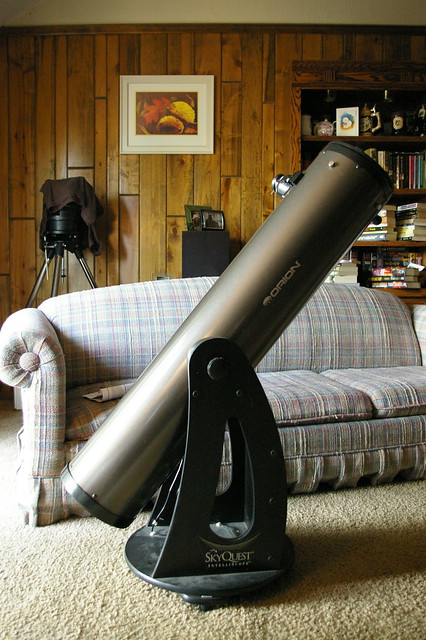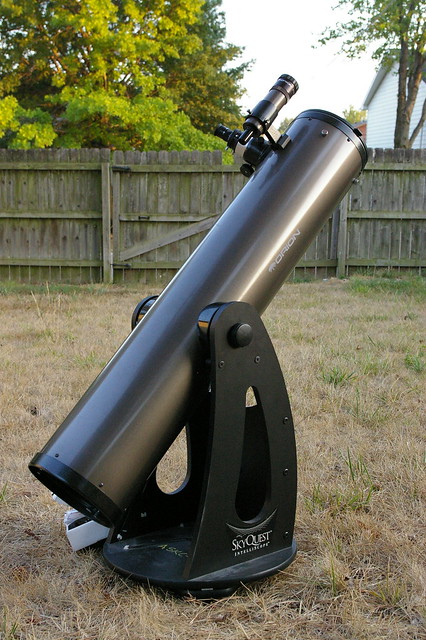
Friday evening I had my first opportunity to really dig in and learn about the telescope I borrowed from my astronomy club. A week ago, Terry and I returned to Kansas City to meet one of the club members at the Warko observatory on the roof of Royall Hall on campus at UMKC. I put in a request to borrow an eight inch Dobsonian telescope (shown at left) to compare and contrast its light gathering abilities with my own ETX-90 (a Maksutov-Cassegrain type telescope). I had high hopes since the aperture on the XT8 is more than twice as big. On the other hand, the ETX-90 is lighter. I drove the van, having hidden the middle set of seats in the subfloor, to make the initial transport of the telescope as easy as possible.
Fast forward an entire week to another Friday evening. After a quick rather disappointing dinner at the local Dairy Queen, Terry and I returned home to separate activities: he to a strings-only practice for one of his bands and me to setting up the loaner scope.
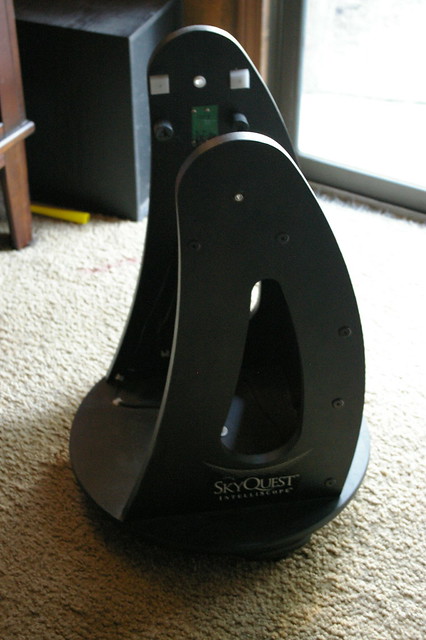
I moved the base into the great room (so called because it’s the biggest room in the house and has a high vaulted ceiling with a floor-to-ceiling corner fireplace). I then re-read the instruction manual, paying close attention to the section dealing with placing the optical tube on the base. The tube weighs just a bit over twenty pounds (the base is a couple of pounds heavier). I picked up the tube, holding it vertically, and rested it gingerly on the bumper stops. I inserted the tension and retaining knobs per the directions and then tested the altitude and azimuth mobility. The base seemed to stick a bit, but nothing that couldn’t be overcome with some nudging.
I attached the finderscope to the optical tube, but did not attempt to adjust it until later, when the tube would be outside and I could find an object to orient on a suitable distance away from my site. I removed the dust cover cap for the tube and for the eyepiece in anticipation for the next phase: collimation

I peered down the optical tube, past the secondary mirror and its spider support system at the large eight inch mirror nestled in the bottom. A small faint circle was inscribed on the surface of the mirror, assumedly in the exact center. I stepped around to the side of the tube and stared down through the eyepiece opening, where I could clearly see my own eye and the small circle mentioned above. My pupil and the circle did not line up exactly, as they should have (see diagram above left).
Upon further reading, and searching through the boxes and bags that the telescope came in, I could not find the collimation cap referenced in the instruction manual: “This cap is a simple cap that fits on the focuser drawtube like a dust cap, but has a hole in the center and a reflective inner surface. The cap helps center your eye so that collimation is easier to perform.” I forged ahead, hoping I could get the mirror aligned ‘close enough’ for some test observing later that night.
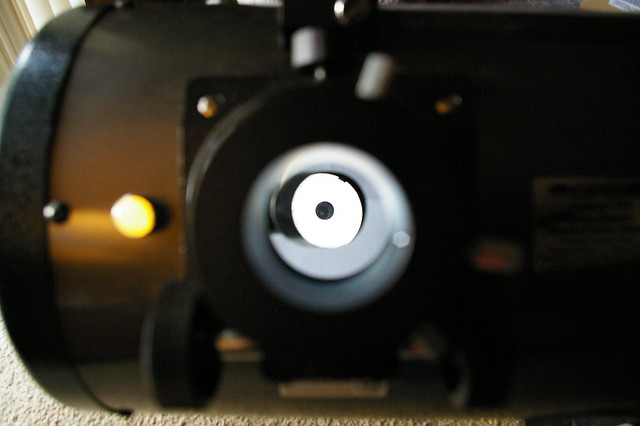 I followed the instructions carefully, reading and re-reading and comparing what I was seeing through the focuser drawtube with the examples provided in the manual. I decided the secondary mirror didn’t need any adjustments, just the primary mirror. The locking thumbscrews on the back of the mirror were already loosened, so I began experimenting with small turns of the larger thumbscrews to adjust the tilt of the primary mirror. I eventually got the small circle in the middle and tightened the locking thumbscrews down. Now to move the unit outside to align the finderscope.
I followed the instructions carefully, reading and re-reading and comparing what I was seeing through the focuser drawtube with the examples provided in the manual. I decided the secondary mirror didn’t need any adjustments, just the primary mirror. The locking thumbscrews on the back of the mirror were already loosened, so I began experimenting with small turns of the larger thumbscrews to adjust the tilt of the primary mirror. I eventually got the small circle in the middle and tightened the locking thumbscrews down. Now to move the unit outside to align the finderscope.
I tilted the tub vertical, grasped the convenient handle on the back of the base with my right hand, keeping the tube vertical with my lefthand. I walked slowly out the back door on the patio and down to the lower level of my back yard, away from (as much as that is possible) the surrounding trees (mine and my neighbors). I needed to find an object about a quarter of a mile away to align the finderscope. Because I live in a valley (Fawn Valley to be precise), everything, including the ground, is up from my backyard, and most of the horizon is blocked by houses and trees. I could barely see the road leading up the hill to where City Hall stands, a couple of blocks to my south. That would have to do. I quickly and easily got the finderscope dialed in.
Now, I had to wait for darkness to fall. I brought out my eyepieces (the three that came with the scope I left in the box with the solar filter) so they and the scope could reach a temperature equilibrium with the outside environment. I went back inside and reviewed the Astro Quest observing award object list and my sky atlas to determine a short list of objects to observe before the moon rose high enough to wash out the night sky.
At half past nine, I went back outside, knowing I’d be able to find Saturn and Mars in the southwestern sky. I did and quickly tried nearly every eyepiece I had, from a 30 mm down to a 9 or a 4 mm. I doubled a couple of those using a 2x barlowe lens. I could clearly see the Cassini division in the rings, but did not try to discern any cloud variances on Saturn’s surface.
I pointed the scope at Mars next, but again, while a bright ruddy object, the red planet still seemed just the size of a pinhead, no matter how much magnification I attempted to throw at it. I guess I need to ask some club members for assistance with seeing well enough to find the polar ice caps. Perhaps I’m just too late in the year, since Mars now sets an hour or two after sunset and I’m looking through so much thick, dirty, hazy, humid air.
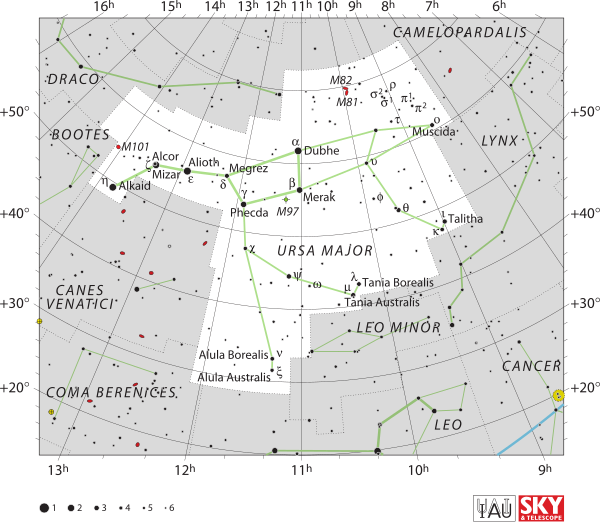 I could tell the moon had risen, but still remained low in the east, hidden behind houses and my tall pin oak in my front side yard. My observing goals for the evening included three multiple star systems. The first one I had actually observed when I first got the ETX-90 back in October 2010. The middle star of the handle of the Big Dipper is actually an optical double star, Mizar-Alcor. Terry joined me in observing this popular duo.
I could tell the moon had risen, but still remained low in the east, hidden behind houses and my tall pin oak in my front side yard. My observing goals for the evening included three multiple star systems. The first one I had actually observed when I first got the ETX-90 back in October 2010. The middle star of the handle of the Big Dipper is actually an optical double star, Mizar-Alcor. Terry joined me in observing this popular duo.
 My second observing goal could be found in the constellation Lyra, containing the brightest star in the summer sky, Vega, and one of the three stars that form the asterism commonly referred to as the Summer Triangle. Finding Vega turned out to be easy. Correctly adjusting the movement of the telescope when aimed directly overhead, not so easy. I had to run back inside to find my red flashlight and grab my reading classes and sky atlas before attempting to star hop the very short distance from Vega to Epsilon Lyrae, also known as the Double Double. In hindsight, I also had forgotten to confirm how many degrees field of view the finderscope provided me (five degrees from the spec page of the instruction manual read this morning). Because of the light pollution around my house and the rising nearly full moon, I could only see Vega and the beta and gamma stars of Lyra. I could clearly see a triangle in the finderscope with one of the three stars Vega for sure, but which one was the Double Double? I may have observed it last night, but I’m not entirely sure. I plan to retry tonight, provided the predicted thunderstorm activity fades before ten o’clock or soon after.
My second observing goal could be found in the constellation Lyra, containing the brightest star in the summer sky, Vega, and one of the three stars that form the asterism commonly referred to as the Summer Triangle. Finding Vega turned out to be easy. Correctly adjusting the movement of the telescope when aimed directly overhead, not so easy. I had to run back inside to find my red flashlight and grab my reading classes and sky atlas before attempting to star hop the very short distance from Vega to Epsilon Lyrae, also known as the Double Double. In hindsight, I also had forgotten to confirm how many degrees field of view the finderscope provided me (five degrees from the spec page of the instruction manual read this morning). Because of the light pollution around my house and the rising nearly full moon, I could only see Vega and the beta and gamma stars of Lyra. I could clearly see a triangle in the finderscope with one of the three stars Vega for sure, but which one was the Double Double? I may have observed it last night, but I’m not entirely sure. I plan to retry tonight, provided the predicted thunderstorm activity fades before ten o’clock or soon after.
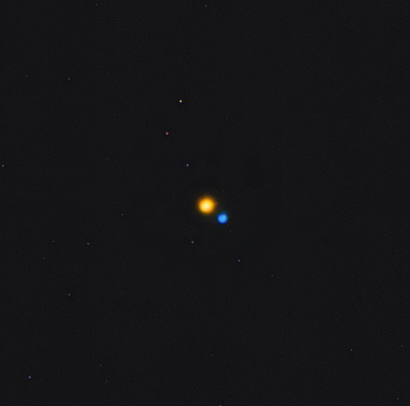
My final observing objective also appeared almost directly overhead, this time in the constellation Cygnus. The head of the swan (Beta Cygni also known as Albiero) is a striking colorful double star that I easily found and observed for a few minutes. Terry also took a quick look, but opted to let the mosquitoes and chiggers feast on me instead of him. Since the moon would soon escape the defense put up by my pin oak, I asked Terry to help me carry the telescope back into the house while I held the red flashlight overhead to light our path.
I put all the eyepieces back in their cases and all the dust caps on all the openings of the telescope. I recorded two of my three observations on my Astro Quest sheets. Terry, Apollo, Lexy and I all retired to bed and left the moon to play by itself through the short summer night.
Some pros and cons about the Dobsonian telescope: I like the improved light gathering capabilities. I love the finderscope (it’s a very good quality one), but would love it more if it had a right-angle viewer. I did not like the height of the eyepiece on the side of the tube. I will need to get a portable stool to lean against. My back is still aching this morning from the constant bent over position I found myself in last night.
Overall, I enjoyed my first foray among the stars with the SkyQuest. I did not use the Intelliscope handheld device that would have assisted in identifying and locating objects. I will save that adventure for another night, possibly at a darker site.

